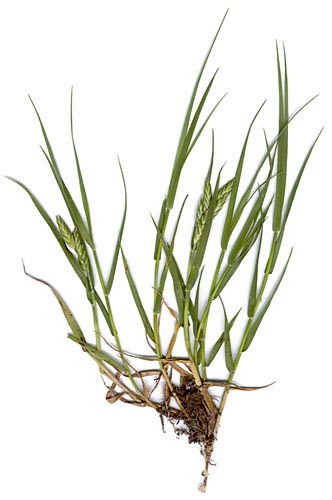Saltgrass

Common Name(s):
Inland Saltgrass
Alkali Saltgrass
Saltgrass
Scientific Name:
Distichlis spicata (L.) Greene
Scientific Name Synonyms:
Distichlis stricta (Torr.) Rydb.
Symbol:
DISP
Description:
Life Span: Perennial
Origin: Native
Season: Warm
Growth Characteristics: A low-growing sodgrass, 4 to 16 inches tall, with tough, scaly rhizomes and rigid stems. It starts growth in the early summer, and has a slow growth rate. It remains green until fall. Few seeds are produced; reproduction is mostly from rhizomes.
Seedhead: Contracted, dense panicle, yellowish at maturity; dioecious; male seedheads larger, more dense, and on longer culms; spikelets flattened, awnless, produces 8 to 15 florets.
Leaves: Scattered, hairy; blades stiff, flattened at base, sharp pointed, coarse, spaced along the entire length of the stem; sheaths overlap; leaves folded in the bud; collar hairy; ligule has a fringe of short hairs; auricles absent.
Ecological Adaptions:
Saltgrass grows from the low valley bottoms to the middle sagebrush grass zone. It is most common in wetlands associated with broad, flat valleys and basins, in swales, on the margisn of ponds, lakes and reservoirs, and in seepage areas. In Utah, it can be seen in many river bottoms as a rather solid, yellowish-green colored sod. The elevation range is between 2500 and 6000 feet, and rainfall from 8 to 14 inches. It is quite resistant to fire and trampling.
Saltgrass has several adaptations to its habitat. Salt glands on the leaves extrude salt, allowing the plants to utilize salty water. It can survive flooding and heavy saturated soils if the leaves are exposed to air, allowing air to be moved from the leaves to the roots through a series of interconnected passages. The sharp-pointed scaly rhizomes effectively push through heavy clay soils, allowing saltgrass to colonize areas less favorable for seedling establishment.
Soils: It occupies primarily extremely salty and alkaline soils that are poorly drained and have a high water table.
Associated Species: Alkali sacaton, greasewood, and pickleweed.
Uses and Management:
Saltgrass is of low palatability for livestock and big game, receiving use only after other forages have cured in the late summer. If grazed alone in the fall or winter, saltgrass can cause rumen compaction in cattle. Saltgrass can provide important benefits in livestock management. It is one of the most resistant grasses to trampling and grazing, providing soil stabilization in areas of trailing and water developments. Care should be taken because it may aggressively increase when competition with other plants is reduced or lacking.
Small mammals and birds use saltgrass for cover, nesting, as well as eating the rootstocks and seeds.
It is very tenacious as a soil erosion control plant, but is usually not found where erosion is a problem. It also has some value in slowing the overland flow of water and reducing the salinization of fresh water streams.
Native Americans in Nevada and Utah used saltgrass as a cereal crop.

